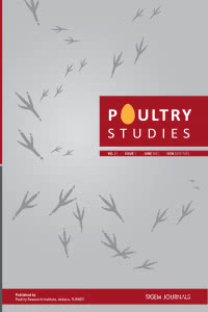Yeni Bir Teknoloji ile Kurutulan Tavuk Dışkısının Mikrobiyolojik ve Kimyasal Yapısının Belirlenmesi
Tavukçuluk işletmelerinde çevre sorunlarına neden olan atıklar, aynı zamanda önemli bir ekonomik potansiyeldir. Tavukçuluk atıklarının işlenmesinde farklı yöntemler kullanılmaktadır. Sistemin seçiminde iklim, hayvan türü, kapasite, ekonomik koşullar ve yeniden kullanım amacı etkili olmaktadır. Tavukçuluk atıklarının işlenmesinde aerobik ve anaerobik işlemler, kompostlama, yakma gibi yöntemlerin yanı sıra son yıllarda farklı kurutma teknikleri de kullanılmaktadır. Bu çalışmada, yeni bir sistemle kurutulan tavuk dışkısının mikrobiyolojik, kimyasal değerleri üzerinde durulmuştur. Kurutma öncesi kullanılan tavuk dışkısının Fekal Koliform (FK) ve Toplam Koliform (TK) sayıları sırasıyla 1.3x106 kob/g ve 2.8x106kob/g olarak belirlenmiş olup, kurutma sonrası aynı değerler <10 kob/g ve 30 kob/g olarak bulunmuştur. Kurutma öncesi Organik azot (OA); Toplam Azot (TA); Toplam Fosforpentaoksit (TF, P2O5); Suda Çözünür Potasyum Oksit (SPO, K2O); Nem ve Uçucu madde (NUM) ve pH değerleri sırasıyla %1.6, %1.8, %2.7, %1.7, %65.6 ve 8.5 olarak analiz edilmiş olup, kurutma sonrası aynı değerler sırasıyla %3.2, %5.4, %4.1, %4.8, %11.2 ve 7.1 olarak gerçekleşmiştir. Yapılan ikinci bir çalışmada kurutma sonrası peletlenmiş tavuk dışkısının kimyasal yapısı üzerinde durulmuş olup, NUM; TA; Toplam Organik Karbon (TOK); pH ve Kalorifik Değer (KD) değerleri sırasıyla %24.9, %1.6, %37.1, 7.2 ve 14.896 kJ/kg olarak analiz edilmiştir. Yapılan analizler doğrultusunda ekonomik olduğu sürece geliştirilen yeni kurutma sisteminin, tavuk dışkısının çevreye zarar vermeden uzun süre depolanması veya biyogaz üretim, kompostlama ve diğer işleme metotları sonrasında elde edilen ürünün nem ve içerdiği mikroorganizma yapısının istenilen düzeye getirilmesinde kullanılabilir olduğu sonucuna varılmıştır
Anahtar Kelimeler:
Tavuk dışkısı, kurutma, mikrobiyolojik özellikler, kimyasal kompozisyon, peletleme
Microbiological and Chemical Changes of Chicken Feces in A New Drying Technology
Poultry waste causing environmental problems enterprises, but also an important economic potential. Different methods are used in the processing of poultry waste. The selection of the system climate, animal type, capacity, economic conditions and the purposes of re-use is effective. Aerobic and anaerobic processing as a waste managing operations of poultry feces, composting, such as burning, as well as the methods used in recent years, different drying techniques. In this study, the microbiological and chemical values of chicken feces are emphasized with new drying system. Prior to drying, the fecal coliform (FK) and total coliform (TK) counts of the chicken feces were determined as 1,3x106 and 2,8x106 respectively, after dried the same parameters were found as <10 and 30 respectively. Prior to drying the organic nitrogen (OA), total nitrogen (TA), total phosphorus pentoxide (TF, P2O5), potassium oxide soluble in water (SPO, K2O), moisture and volatile matter (NUM) and pH values were 1.6%, 1.8%, 2.7%, 1.7%, 65.6%, and 8.5, respectively; after dried, the same parameter values were found as 3.2%, 5.4%, 4.1%, 4.8%, 11.2% and 7.1 respectively. In a second study, after drying focused on the chemical structure of pellets chicken feces and their moisture and volatile matter, total nitrogen, total organic carbon (TOK), calorific value (KD) and pH values were found 24.9%, 1.6%, 37.1%, 14.896 kJ/kg and 7.2 respectively. As long as according to the analyzes of economic, the development of new drying system concluded that available in long-term storage of chicken feces without harming the environment or biogas production, composting and the product obtained after other processing methods which is bringing the desired level of moisture and structure of microorganism.
Keywords:
Poultry manure, drying, microbiological structure, chemical structure, pelleting,
- ISSN: 1302-3209
- Yayın Aralığı: Yılda 2 Sayı
- Başlangıç: 1999
- Yayıncı: Tavukçuluk Araştırma Enstitüsü Müdürlüğü
Sayıdaki Diğer Makaleler
Altlığa İlave Edilen Doğal Zeolitin Etlik Piliçlerin Performansı ve Refahına Etkileri
Erol BİNTAŞ, Kamil KÜÇÜKYILMAZ, Mehmet BOZKURT, Abdullah Uğur ÇATLI, Mustafa ÇINAR, Sabri TOPBAŞ, Bahattin Koçer, Gökhan EGE
Yeni Bir Teknoloji ile Kurutulan Tavuk Dışkısının Mikrobiyolojik ve Kimyasal Yapısının Belirlenmesi
Organik Tavukçulukta Mera Kompozisyonu, Besleme ve Barındırma Teknikleri
Hasan ELEROĞLU, Arda YILDIRIM, Ahmet ŞEKEROĞLU
Musa SARICA, Umut Sami YAMAK, Mehmet Akif BOZ, Ahmet UÇAR
